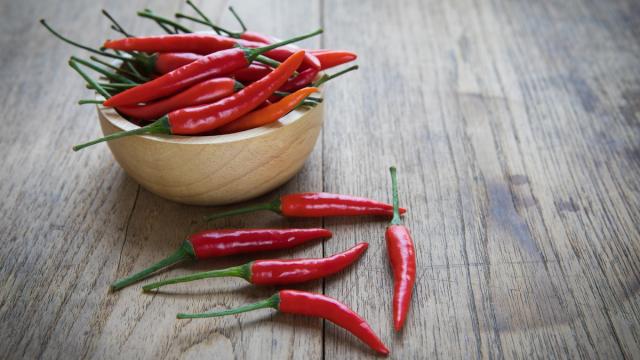Chili can add a bit of pizzazz to any meal but it can also be a painful addition. Milk is a great antidote when you’ve taken a bite of something a little too spicy but it’s not always on hand. Thankfully, there are alternatives.
Why does chili burn?
The key reason chilis make your mouth and skin burn is all thanks to a little guy called capsaicin. It’s a chemical compound that reacts with the receptors on your tongue or skin and sends messages to the brain that it’s in pain. Your tongue isn’t dying but it certainly feels like it.
There are a number of chili types and they each vary in hotness. These chilis can be measured for ‘hotness’ via the Scoville scale. Mild chili variations, like the capsicum, rate fairly low at around 100 Scoville Heat Units (SHU) while jalapeños come in at around 3,500 to 8,000 SHU. One of hottest chilis in the world, the Carolina Reaper, comes in at around 1.5 million on the scale.
At the higher end of the scale, a simple mouth burn would be an easy way out. Most humans react to this extreme exposure to capsaicin by breaking out in sweats, developing a rash and even struggling to breath. Shows like the popular YouTube series, Hot Ones, are a fun way to vicariously experience the scary end of the Scoville scale without actually subjecting yourself to it.
Why does milk help?
Capsaicin is hydrophobic, meaning it won’t attach to water. So if you’re experiencing a chili burn in your mouth or on your skin, washing it out with water will do very little and may just spread the pain further.
That’s why milk, particularly full cream, works best. Milk is a fatty liquid and contains a protein called casein. It attaches to the capsaicin and neutralises the burning sensation you’re feeling. Similarly, yoghurt and cow-milk based creams will also do the job.
While most chili burns are felt from eating spicy food, it can also be from preparing dishes with chili. The other night I was cutting up some garden chilis and while I did wash my hands after, it was apparently not rigorous enough. I then proceeded to touch my nose, which began burning. I dabbed some milk onto a paper towel and popped it on my nose and that helped a bit.
About half an hour later, I rubbed my eye and apparently, still had some chili remnants on my fingers. I had to work quickly and the milk solution was not going to cut it…
…and if you’re out of milk?
Sometimes you just don’t have milk laying about. While that was not the case for me, it wasn’t enough to do the job of a sudden chili-to-the-eye situation.
Aside from milk, capsaicin burns can be neutralised by soap, high-percentage alcohol (vodka because beer or wine won’t cut it) as well as a baking soda and water mixture.
None of these are eye-friendly.
Luckily, there are also cooking oils. Olive and vegetable oil that will do the trick and it certainly worked in my case. A quick dab on an olive-oil soaked paper towel to the eye quickly diffused my panic and softened the burn.
It’s also a good idea to properly neutralise your hands after you’ve finished preparing chilis. Olive or vegetable oil are probably your safest bet there. I know I’ve certainly learned my lesson now.

Leave a Reply
You must be logged in to post a comment.